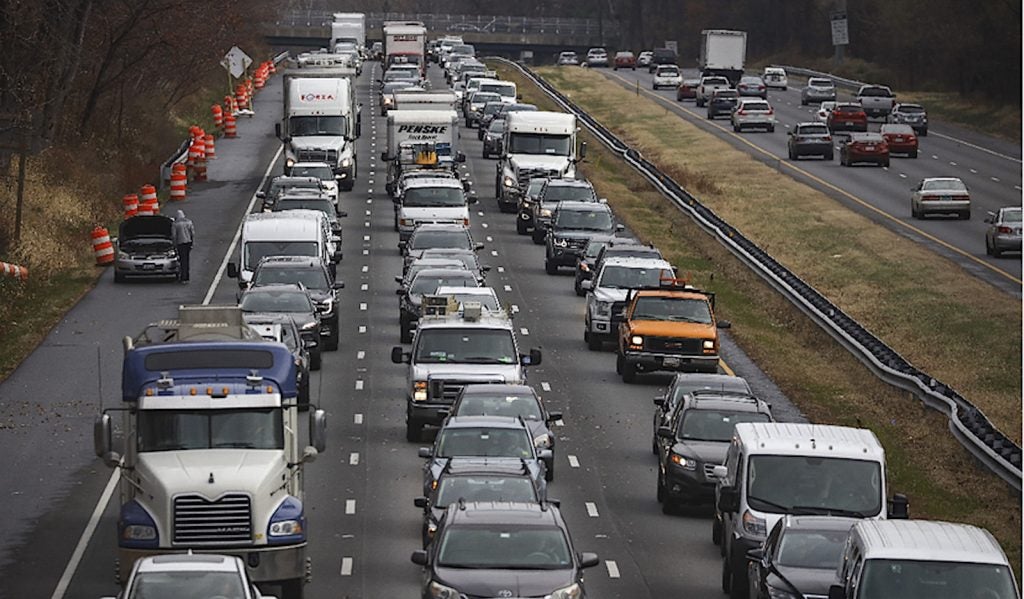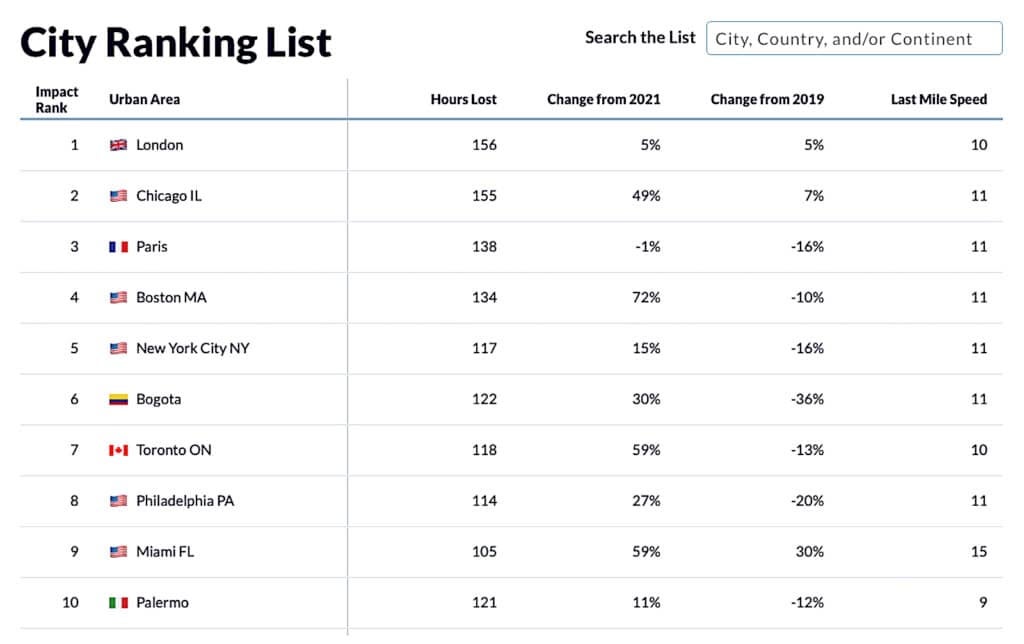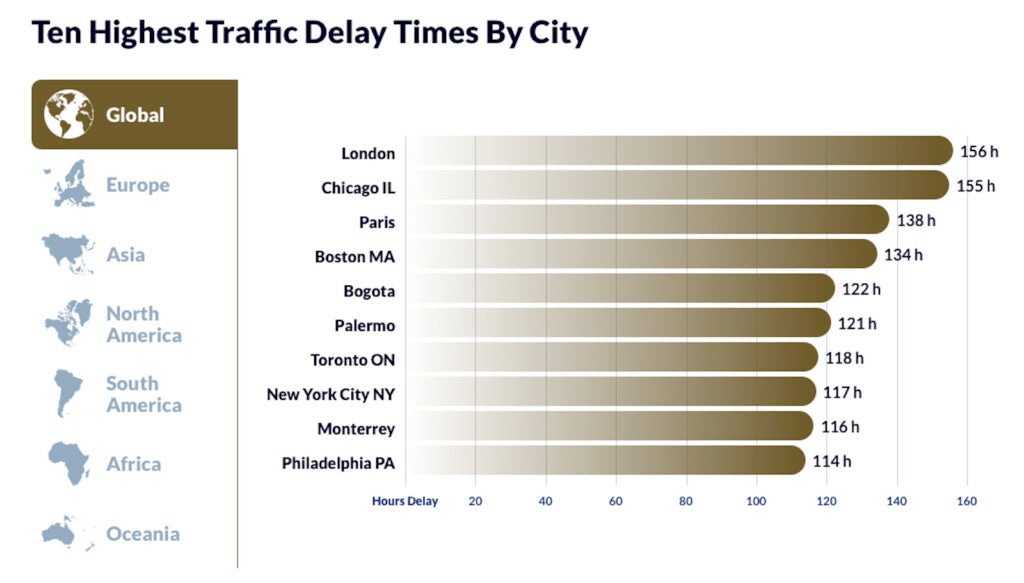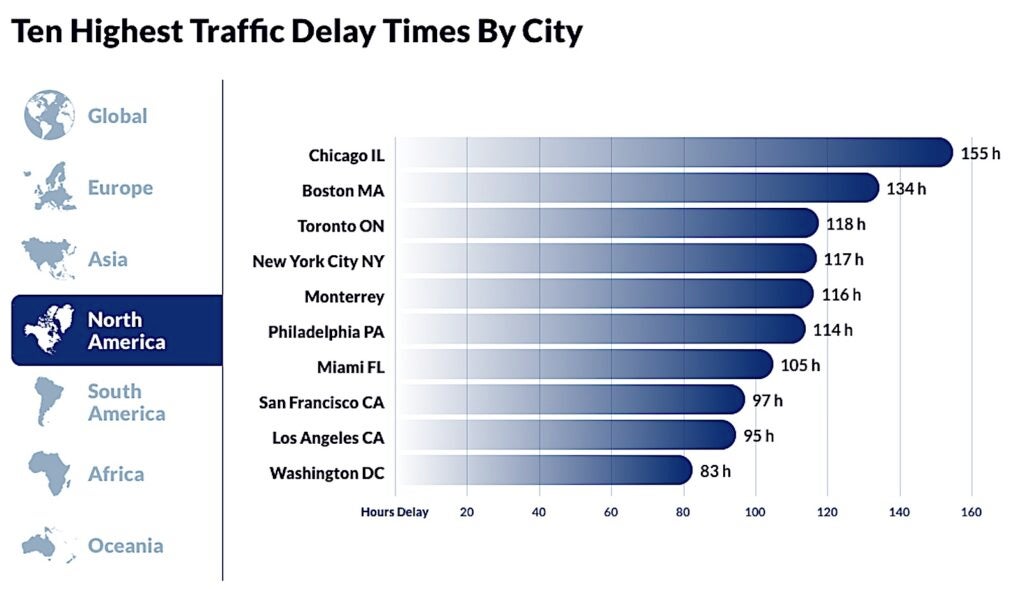If there was one good thing to come out of the global COVID pandemic, it was that traffic got better. That benefit persisted in 2022, though things are clearly returning to a normal that no one really likes.

Wasting time on the highway is bad for anyone, but some of us have it much worse than others. The 2022 Global Traffic Scorecard published by Inrix, identifies and ranks congestion and mobility trends in more than 1,000 cities across 50 countries. This year’s scorecard has some interesting findings about how Americans are changing their work and commuting habits.
Within the United States, Chicago drivers lost the most time to traffic congestion at 155 hours, but they were closely followed by drivers in Boston with 134 hours lost and New York at 117 hours. Those three cities were all in the top five for most congested cities in the world, alongside London drivers at 156 hours and Paris drivers at 138 hours.
The typical American driver wasted 51 hours in congestion, which is up 15 hours from 2021, but still nearly 50% below pre-pandemic levels. The numbers reflect a trend of businesses bringing their employee back to the office. Bringing back the commute is costing the average driver $869 in time lost, up $305 from last year, and higher fuel costs saw an average increase of $129 being spent at the gas pump over the course of the year.
“2022 was shaping up to be a year of re-emergence and a return to a new, post-pandemic behavioral norm, but that halted with the rise in oil prices, supply chain disruptions, and inflation,” said Bob Pishue, transportation analyst at INRIX.

“Despite geopolitical and economic uncertainties, we continued to see a rise in global vehicle-miles traveled, a return toward traditional morning and evening peak commutes, growth in public transportation use, and continued gains in downtown travel. However, we have yet to fully rebound to pre-pandemic levels, and while we do anticipate a gradual increase over the coming years, we may see a small decline in 2023 should a global recession strongly take hold.”
The worst traffic cities also cost the most
Drivers in Chicago lost the most time to traffic congestion in the U.S., with an increase of 7% compared to pre-COVID congestion levels. Chicagoans were only an hour behind Londoners for the most congested city in the world. Boston and New York were next in the U.S., the fourth and fifth most congested cities in the world. Despite their high rankings and year-over-year increase in congestion, Boston and New York are still better than pre-COVID congestion levels at 10% and 16% respectively.
Across the United States, average traffic delays were still below pre-COVID levels in more than 60% of urban areas and weekday vehicle-miles traveled remained 9% below pre-COVID levels. However, fuel price increases still raised the price of commuting. In the U.S., national pre-pandemic prices for regular unleaded were at $2.35 per gallon in February 2020. Prices hit a high of $4.76 during June 2022, before receding to $3.25 per gallon in December 2022. This has led to increases in freight costs, commuting costs, and the prices consumers pay for goods and services.

As a national average, higher fuel costs resulted in the average commuter paying $129 more at the gas pump over the year. Yet depending on location, fuel prices vary considerably. For example, the annual cost of fuel per driving commuter increased nearly $350 in Los Angeles compared to 2021, while drivers in Chicago paid $288 more to commute to work in 2022.
Telecommuting is still a thing
Despite the return to office culture, telecommuting and hybrid work schedules have continued to remain relatively strong options for employees. With a general increase in hybrid work schedules and decrease in telecommuting schedules, trips to employment centers generally increased to downtown/city centers since their COVID-19 nadir, though not all downtowns saw increases over 2021, and many started from significant deficits as shown in previous years’ Global Traffic Scorecards.
Among those U.S. downtowns analyzed, Washington, D.C. saw the largest jump in downtown trips compared to last year, followed by Charlotte, Detroit, New York, San Diego, San Francisco, Portland, Seattle, Phoenix and Boston. Despite the increase in trips to city centers, traffic volumes in most metros remain below pre-COVID levels.
The most congested corridors in the U.S.
It’s well-known that the design and capacity of roads contributes to congestion, and some places are the worst of the worst. For example, I-95 through Stamford, Connecticut was the most congested, or the third most congested, corridor in the country depending on the direction of travel.

I-5 southbound in Los Angeles was the second most congested corridor, as drivers lost an average of 31.8 minutes per day at the 5 p.m. rush hour. A driver taking that route 240 workdays a year would have lost on average 127 hours a year sitting in traffic.
Other notable corridors are I-93 southbound through downtown Boston to the Pilgrim Highway Interchange, which caused an average of 24.7 minutes lost per day at 4 p.m., and Westbound Brooklyn Queens Expressway to Tillary Street in New York City, which caused an average of 22.6 minutes lost per day at 4 p.m.
How U.S. cities compare to top cities worldwide
At the global level, London topped the list of the cities most impacted by traffic congestion for the second straight year with congestion up 5% year-over-year and up 5% from pre-COVID levels. Chicago was the second most congested city globally, followed by Paris, Boston, New York, Bogota, Toronto, Philadelphia, Miami and Palermo. How Tokyo did not make the list is something of a mystery. Still, drivers in seven of the top 10 cities still spent less time in traffic in 2022 than they did pre-COVID.
It’s unlikely that anyone will find a solution to urban traffic any time soon, but clearly telecommuting and flexible work hours help keep overall traffic delays down, as well as saving fuel and pollution costs.
- SEO Powered Content & PR Distribution. Get Amplified Today.
- Platoblockchain. Web3 Metaverse Intelligence. Knowledge Amplified. Access Here.
- Source: https://www.thedetroitbureau.com/2023/01/no-surprises-traffic-is-bad-all-over-the-world/



